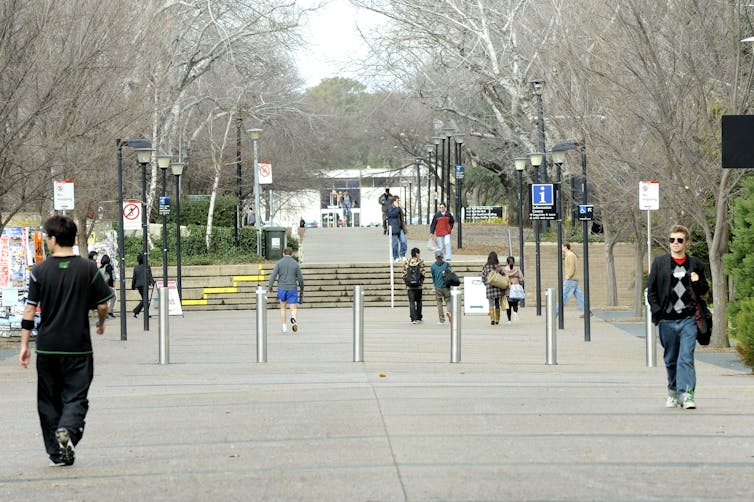ANU's new entrance criteria won't do much to improve equity
- Written by Shane Duggan, Vice Chancellor's Postdoctoral research fellow, RMIT University
The Australian National University recently announced that from 2020 it will require all students to meet co-curricular requirements alongside the Australian Tertiary Admission Rank (ATAR) requirement.
The diverse list of co-curricular requirements includes part-time employment, participation in the creative arts, sports, and community and service activities. Academic internships, international exchange, and scholastic activities such as the prestigious Google Science Fair are also recognised under the scheme.
This represents perhaps the largest admissions policy shift from a Group of Eight university to date. It’s a clear indication the national university is looking beyond the ATAR to ensure it attracts the most suitable young people to its courses. But it will not do much to improve equity of access.
Anti-ATAR sentiment
Sentiment against the Australian Tertiary Admissions Ranking (ATAR) is rising.
Read more: Should we scrap the ATAR? What are the alternative options? Experts comment
A Fairfax report in 2016 showed universities were accepting students with ATARs much lower than advertised cut-off scores. The report confirmed suspicions university admissions are opaque and at risk of being gamed by schools.
Since then, there have been calls across the sector to increase transparency around how ATAR is used for university entrance. And a rising chorus suggests the ATAR should be scrapped all together.
More recently, Australia’s chief scientist Alan Finkel has emerged as a fierce opponent of the ATAR system, going as far as to suggest the system is “completely obscure” and results in students “being given poor advice” about their post-secondary options.
What has changed?
The majority of universities across the country already accept some students based on other-than-ATAR requirements. These include portfolios, interviews, and community service. Most also allocate a number of places to students from underrepresented communities, and specific pathways for Aboriginal and Torres Strait Islander young people.
What’s different about ANU Vice-Chancellor Brian Schmidt’s announcement last week is the specific commitment by a high status, research-intensive university to base admissions on more than “just a score”.
The addition of a co-curricular or “service” requirement follows an announcement by Professor Schmidt in 2016 that the national university was looking to “move away from judging students only on their year 12 ATAR results”.
 As of 2020, ANU will be looking at things such as part-time employment and community engagement as entrance criteria.
Dan Peled/AAP
As of 2020, ANU will be looking at things such as part-time employment and community engagement as entrance criteria.
Dan Peled/AAP
The move will see students required to meet a threshold of out-of-class activities alongside the ANU floor ATAR of 80 for admission to most courses. ANU has two advantages which allow it to take this policy position:
the lowest ATAR admitted to ANU in 2018 was close to 80.00, which means ANU draws almost exclusively from the top quintile of results overall
ANU enjoys a remarkably high completion rate, with over 80% successful completions between 2009 and 2014.
This policy may help to attract students with a “near-miss” on their admission into high-status degrees. By necessity, it will certainly encourage already high performing students to look beyond their academic studies and develop their whole selves in the final years of secondary school.
But it won’t dramatically alter the student cohort in terms of encouraging low-SES students to apply. These students are significantly more likely to achieve an ATAR under 80 than their more advantaged peers
Rather, ANU’s co-curricular or service requirement will increase competition for places at the lower-end of those students the university already accepts. It gives the university a powerful lever with which to allocate university places moving forward. This is especially important given the increased scrutiny on the use of ATAR as the sole basis for university admissions.
What does this mean for equity?
ANU’s plan has drawn praise from Federal Minister for Education and Training Simon Birmingham. He suggested the policy represents a “commitment to welcome, educate and accommodate the best and brightest Australians, regardless of their background”.
Professor Schmidt has positioned these changes as an access measure. But as higher education policy expert Andrew Norton notes, high-socioeconomic young people tend to perform better on these kinds of co-curricular requirements than their less advantaged peers.
Read more: Your ATAR isn't the only thing universities are looking at
Non-academic requirements are very common overseas. The US is the most prominent example, where students are required to apply directly to each institution. That system is widely criticised as advantaging high-socioeconomic students who often enjoy far superior resources, time, and parental support in putting together their applications. There have been significant moves in recent times to address these issues, with the continued adoption of common application processes.
Multiple factors influence young people’s readiness for tertiary study. This is especially true for students from diverse, underrepresented, and low-socioeconomic backgrounds.
 Low-socioeconomic status students require significant additional supports.
Alan Porritt/AAP
Low-socioeconomic status students require significant additional supports.
Alan Porritt/AAP
First, these young people are at a significant disadvantage in terms of the quality and availability of career planning and counselling.
Second, even after they’re admitted, young people from disadvantaged backgrounds are significantly more likely to drop out. This is often due to beyond-academic reasons, such as balancing work and study, caring responsibilities, and social exclusion.
Read more: The ATAR debate: students need to be able to finish uni, not just start it
Third, the tertiary admissions process, and the use of ATAR remain poorly understood by the community more generally.
Finally, even if these students do succeed, they tend to find it more challenging to secure work experience, and full-time employment after their studies. This is due to more limited professional networks and parental support.
In short, less advantaged students require significant additional supports, well beyond acknowledging their diverse pathways for entry into a degree program. These challenges remain the key litmus test for any debate around the continued usefulness of the ATAR.
Authors: Shane Duggan, Vice Chancellor's Postdoctoral research fellow, RMIT University
Read more http://theconversation.com/anus-new-entrance-criteria-wont-do-much-to-improve-equity-97533





